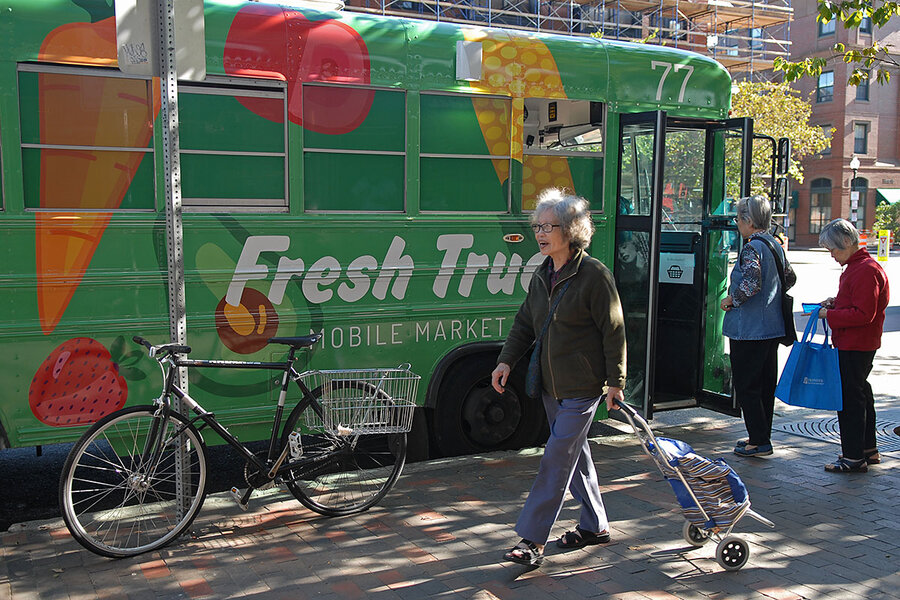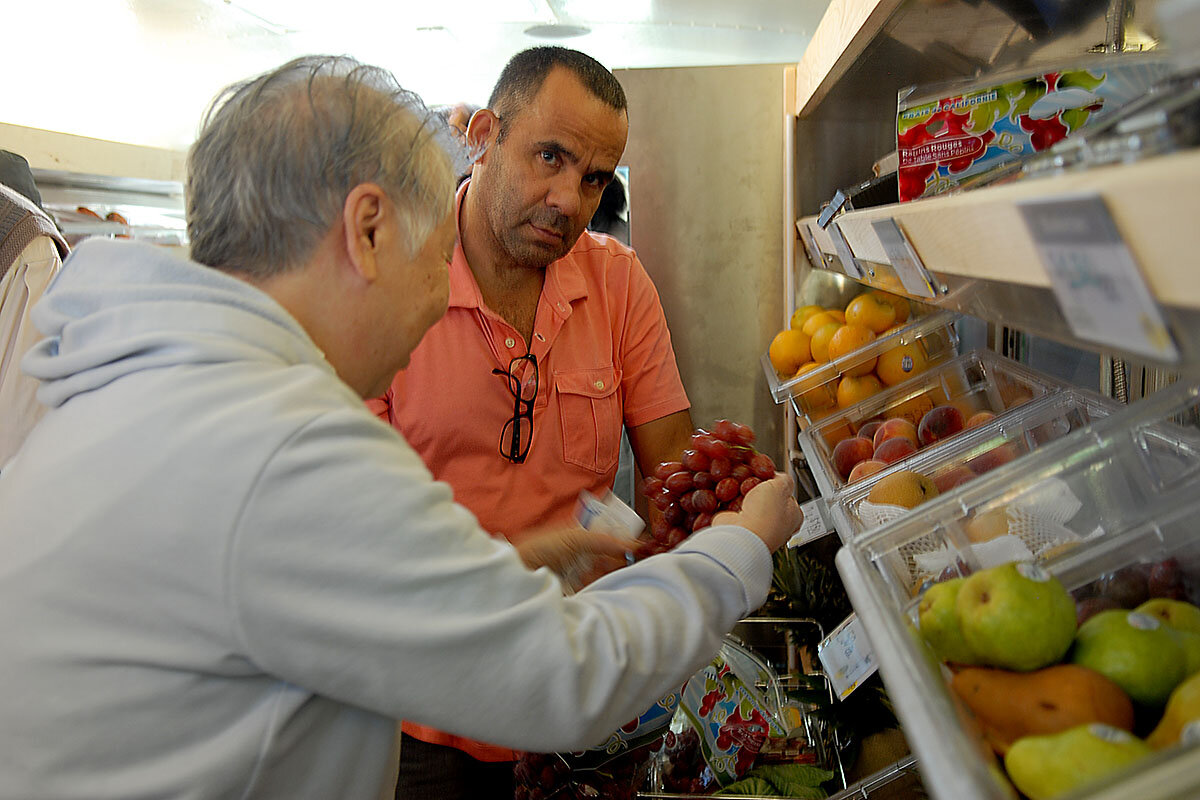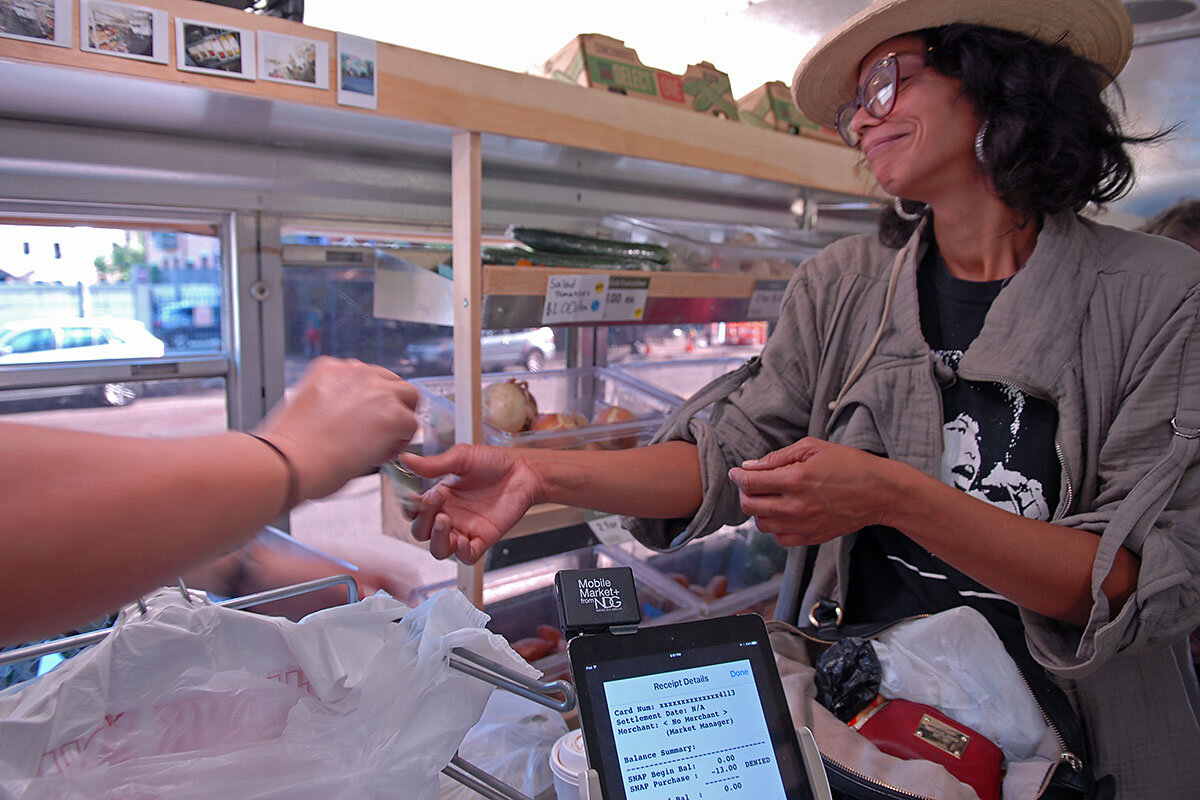Oasis on wheels: mobile markets bring fresh produce into food deserts
Loading...
| Boston
Kemarah Sika and her young daughter line up in front of a brightly painted food truck outside of YMCA in Boston’s Roxbury neighborhood. But it’s not a quick bite they are here to get. They are filling their shopping bags with ears of corns and bunches of kale to cook at home.
“I shop here because it’s convenient,” says Ms. Sika as she waits for her turn at The Trustees Mobile Farmers Market. “I take my daughter to her karate lesson [at the YMCA] every Saturday. It’s easy to get locally grown fresh produce at an affordable price.”
Before the mobile market started rolling through her neighborhood in April, Sika says that she bought fresh produce maybe every other week because “it’s pricey and not as convenient.” Now she includes fresh vegetables weekly in her family's meals.
“I look forward to it every Saturday,” Sika says with a smile.
Providing more fresh produce to urban neighborhoods where grocery stores can be few and far between has long been a focus for those working to balance food offerings among fast food restaurants and corner convenience stores. The proliferation of farmers' markets has helped, with more than 8,000 operating nationwide in the United States. But farmers' markets tend to be located in wealthy neighborhoods and are often out of reach, both physically and economically, for many low-income residents.
A growing number of cities in the US, however, have been trying another tack: food trucks that bring fruits and vegetables directly to low-income communities and that double residents' Supplemental Nutrition Assistance Program (SNAP) dollars.
“[I]f someone wants to go the grocery store, they have to change two different buses, go to the grocery store, get back on the buses with all of their groceries to a bus stop then walk home,” says Hannah Heacox, who has been driving a fresh food truck in Spartanburg, S.C., since July. Her truck is sponsored by Hub City Farmers’ Market, an organization working to increase access to local food. “I’m taking the mobile market to places where it would be very hard otherwise for people to get the food that they need.”
How it works
Mobile market vendors hope their efforts will help redirect eating habits away from fast food.
“The more we can reduce the barriers of [accessing] fruits and vegetable, we know there’s a demand that people want healthy food,” says Eliza Dexter Cohen, the food access coordinator for Food on the Move in Providence, R.I. “This type of program really enables people to eat fruits and vegetables when they wouldn’t otherwise be able to.”
Ms. Cohen and her team drive to 21 sites across Rhode Island weekly, including public and elderly housing sites.
“We know from the NIH [National Institute of Health] studies, this intervention has a particularly high impact on families with young children and older adults,” says Amy Nunn, executive director of Rhode Island Public Health Institute. “Because of that data, we are doubling down on our effort to make sure that those populations are served in our outreach. So we’ve added more senior sites and sites with more working families.”
Food on the Move serves about 6,000 people across Rhode Island. In 2016, the initiative made $120,000 in sales, with a majority of its customers shopping more than once. The numbers for 2017 are expected to increase, says Cohen.
All revenue goes back to fund the mobile market operations, but that’s not enough. Food on the Move also receives grants from United States Department of Agriculture to support their SNAP (formerly known as food stamps) doubling program.
A fertile model?
On average, SNAP participants receive $130 per month per person.
“[O]ne of the biggest public health problems facing the nation with hunger and food and security is that a lot of people’s SNAP benefit ran out at their first grocery run on the 3rd or the 5th of the month,” says Dr. Nunn. “If you are a SNAP recipient, your $1 is worth $2 at [Food on the Move].”
Every time SNAP shoppers purchase produce with their EBT card, they get a SNAP gift card for the same amount.
Nunn hopes one day the USDA could integrate this method into federal policy – and possibly into more traditional grocery stores.
“What if Wal-Mart started doing this? What if Kroger's and Whole Foods started doing this, you could really have an impact,” she says.
In Massachusetts, the Department of Transitional Assistance launched a new program in April that creates a direct farmer-to-SNAP-customer transaction model.
The Healthy Incentives Program, or HIP, matches an equal amount of SNAP dollars back to the participant's EBT cards, with receipts showing the additional SNAP dollars earned. Based on the household size, SNAP recipients can monthly earn up to $40 for one to two people, $60 for three to five people, and $80 for families of six or more.
Since April, there has been more than $2 million in HIP sales at farmers markets, farm stands, mobile markets, and community supported agriculture (CSA) farm-share programs across Massachusetts, four times the amount of SNAP redemption sales in 2016. There are currently 295 locations for HIP participants to buy fresh produce across the state. However, with the multiple stops made by food trucks, those access points increase to 427 locations.
Hope on wheels
In Boston's South End, a bright green school bus painted with corn, carrots, and the words Fresh Truck is perfecting its parallel parking on a busy street. “Five more minutes!” the bus driver shouts out from the bus to the line of people waiting with baskets and carts.
When the door opens, Chrissy, a first-time customer walks in. (As a domestic violence survivor, she declines to give her last name.) She eyes the veggies on the right, fruits on the left, and picks up two ears of corn.
“This gives me hope,” she says as she heads for home.
Editor's note: An earlier version of this article misidentified the sales total for Food on the Move in 2016. The correct number is $120,000.









